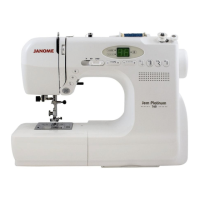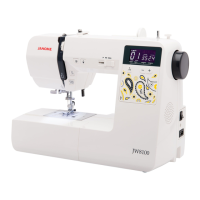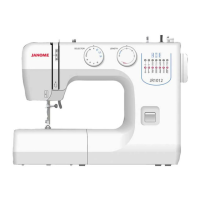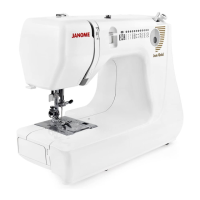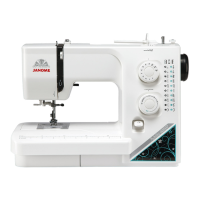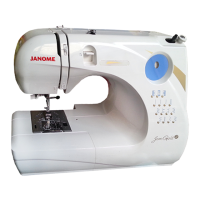Why is my Janome Sewing Machine making a lot of noise?
- TThomas WattsJul 29, 2025
Noisy operation of your Janome Sewing Machine may be caused by: * The feed dog is packed with lint. * Lint has collected in the bobbin holder.
Why is my Janome Sewing Machine making a lot of noise?
Noisy operation of your Janome Sewing Machine may be caused by: * The feed dog is packed with lint. * Lint has collected in the bobbin holder.
Why does the needle thread keep breaking on my Janome JP760 Sewing Machine?
The needle thread may be breaking due to several reasons: * The needle thread is not threaded properly. * The needle thread tension is too tight. * The needle is bent or blunt. * The needle is incorrectly inserted. * The needle thread and the bobbin thread are not set properly under (drawn to the rear of) the presser foot when sewing is starting. * The fabric is not drawn to the rear when sewing is finished. * The thread is too heavy or too fine for the needle.
Why does the needle break on my Janome JP760 Sewing Machine?
The needle may be breaking due to several reasons: * Needle is incorrectly inserted. * The needle is bent or blunt. * The needle clamp screw is too loose. * A proper foot is not used; use proper foot. * The fabric is not drawn to the rear when sewing is finished. * The needle is too fine for the fabric being sewn.
Why is the cloth not feeding smoothly through my Janome Sewing Machine?
The cloth may not feed smoothly because: * The feed dog is packed with lint. * The stitches are too fine; make stitch longer. * The feed dog was not raised after being lowered.
What causes seam puckering on my Janome Sewing Machine?
Seam puckering may occur on your Janome Sewing Machine because: * The needle thread tension is too tight. * The needle thread is not threaded properly. * The needle is too heavy for the fabric being sewn. * The stitch length is too long for the fabric; make the stitch shorter. * Use a stabilizer for very fine fabrics.
Why are the patterns distorted on my Janome Sewing Machine?
Patterns may be distorted on your Janome Sewing Machine if the stitch is not balanced.
Why is the buttonhole not sewn well on my Janome JP760 Sewing Machine?
The buttonhole may not be sewn well on your Janome Sewing Machine if: * The stitch density is not suitable for the fabric being sewn. * Interfacing is not being used with stretch fabrics.
Instructions to reduce the risk of electric shock when using the sewing machine.
Precautions to reduce the risk of burns, fire, electric shock, or injury to persons.
Instruction to retain the safety guidelines for future reference.
Identifies and labels all the parts of the sewing machine for user reference.
Step-by-step guide on how to correctly insert the spool pin into its designated hole.
Instructions for removing and securing the extension table to the sewing machine.
Explanation of the utility of the free arm sewing feature for mending small items.
Steps for connecting the sewing machine to electrical power, including plug and outlet.
Procedure for starting and stopping the machine using the dedicated button.
Procedure for starting, stopping, and controlling speed with the foot pedal.
How to adjust the maximum sewing speed using the slider control.
How to vary sewing speed by pressing the foot control pedal.
Using the button to start and stop the machine's operation.
Function of the reverse button for locking stitches and sewing backward.
Using the auto-lock button for securing stitches automatically at the end of a stitch.
Controlling the needle position (up or down) using the dedicated button.
Guide to adjusting needle thread tension for balanced stitching.
A chart providing recommended needle and thread types for various fabrics.
Steps for safely removing the bobbin from the bobbin case.
Instructions for placing the thread spool correctly for bobbin winding.
How to use the additional spool pin for bobbin winding without unthreading the machine.
Detailed guide for straight stitch: settings, sewing, direction changes, and seam securing.
Settings and use for the basic straight stitch.
Using the lock-a-matic stitch for securing seams and backstitching.
Description of the stretch stitch for knit fabrics and bias seams.
Details on the triple stretch stitch for durable and elastic seams.
Machine settings for pattern, presser foot, and thread tension for zigzag stitch.
How to adjust the width of the zigzag stitch.
How to adjust the length of the zigzag stitch.
Using the zigzag stitch for overcasting fabric edges.
Using the multiple zigzag stitch for finishing stretch fabrics.
Overview of available buttonhole types: Square, Auto, Round-end, Keyhole, Knit.
Machine settings and notes for sewing a square buttonhole.
Procedure for attaching the automatic buttonhole foot R.
Identifying the starting point and using the buttonhole mark.
Stitch pattern, foot, and thread tension for round-end/keyhole buttonholes.
How to adjust the width of round-end buttonholes.
Adjusting the width for buttonholes.
Adjusting the density of stitches for buttonholes.
Procedure for sewing a double layer buttonhole for added sturdiness.
Stitch pattern, foot, and thread tension for round-end/keyhole buttonholes.
Adjusting the width of round-end buttonholes.
Stitch pattern, presser foot, and thread tension for auto buttonhole.
Pattern, presser foot, and tension for zipper sewing.
Instructions for attaching the optional zipper foot.
Steps for preparing the fabric and zipper for sewing.
Step-by-step guide for sewing a zipper.
Instructions for basting the zipper tape to the fabric layers.
How to remove basting stitches after zipper sewing.
Stitch pattern, presser foot, and tension for blind hemming.
Adjusting needle position for precise blind hemming.
How to adjust the eyelet shape if it appears distorted.
Instructions for sewing applique designs onto fabric.
Using stitches to seam patchwork pieces together.
How to correct distorted stretch stitch patterns using the feed balancing dial.
Procedure for cleaning lint and dust from the hook race and feed dogs.
Steps for correctly replacing the bobbin holder.
Table of warning signals, their problems, and troubleshooting steps.
Explanation of different buzzer sounds and their operational meanings.
Instructions to reduce the risk of electric shock when using the sewing machine.
Precautions to reduce the risk of burns, fire, electric shock, or injury to persons.
Instruction to retain the safety guidelines for future reference.
Identifies and labels all the parts of the sewing machine for user reference.
Step-by-step guide on how to correctly insert the spool pin into its designated hole.
Instructions for removing and securing the extension table to the sewing machine.
Explanation of the utility of the free arm sewing feature for mending small items.
Steps for connecting the sewing machine to electrical power, including plug and outlet.
Procedure for starting and stopping the machine using the dedicated button.
Procedure for starting, stopping, and controlling speed with the foot pedal.
How to adjust the maximum sewing speed using the slider control.
How to vary sewing speed by pressing the foot control pedal.
Using the button to start and stop the machine's operation.
Function of the reverse button for locking stitches and sewing backward.
Using the auto-lock button for securing stitches automatically at the end of a stitch.
Controlling the needle position (up or down) using the dedicated button.
Guide to adjusting needle thread tension for balanced stitching.
A chart providing recommended needle and thread types for various fabrics.
Steps for safely removing the bobbin from the bobbin case.
Instructions for placing the thread spool correctly for bobbin winding.
How to use the additional spool pin for bobbin winding without unthreading the machine.
Detailed guide for straight stitch: settings, sewing, direction changes, and seam securing.
Settings and use for the basic straight stitch.
Using the lock-a-matic stitch for securing seams and backstitching.
Description of the stretch stitch for knit fabrics and bias seams.
Details on the triple stretch stitch for durable and elastic seams.
Machine settings for pattern, presser foot, and thread tension for zigzag stitch.
How to adjust the width of the zigzag stitch.
How to adjust the length of the zigzag stitch.
Using the zigzag stitch for overcasting fabric edges.
Using the multiple zigzag stitch for finishing stretch fabrics.
Overview of available buttonhole types: Square, Auto, Round-end, Keyhole, Knit.
Machine settings and notes for sewing a square buttonhole.
Procedure for attaching the automatic buttonhole foot R.
Identifying the starting point and using the buttonhole mark.
Stitch pattern, foot, and thread tension for round-end/keyhole buttonholes.
How to adjust the width of round-end buttonholes.
Adjusting the width for buttonholes.
Adjusting the density of stitches for buttonholes.
Procedure for sewing a double layer buttonhole for added sturdiness.
Stitch pattern, foot, and thread tension for round-end/keyhole buttonholes.
Adjusting the width of round-end buttonholes.
Stitch pattern, presser foot, and thread tension for auto buttonhole.
Pattern, presser foot, and tension for zipper sewing.
Instructions for attaching the optional zipper foot.
Steps for preparing the fabric and zipper for sewing.
Step-by-step guide for sewing a zipper.
Instructions for basting the zipper tape to the fabric layers.
How to remove basting stitches after zipper sewing.
Stitch pattern, presser foot, and tension for blind hemming.
Adjusting needle position for precise blind hemming.
How to adjust the eyelet shape if it appears distorted.
Instructions for sewing applique designs onto fabric.
Using stitches to seam patchwork pieces together.
How to correct distorted stretch stitch patterns using the feed balancing dial.
Procedure for cleaning lint and dust from the hook race and feed dogs.
Steps for correctly replacing the bobbin holder.
Table of warning signals, their problems, and troubleshooting steps.
Explanation of different buzzer sounds and their operational meanings.
| Brand | Janome |
|---|---|
| Model | JP760 |
| Category | Sewing Machine |
| Language | English |
